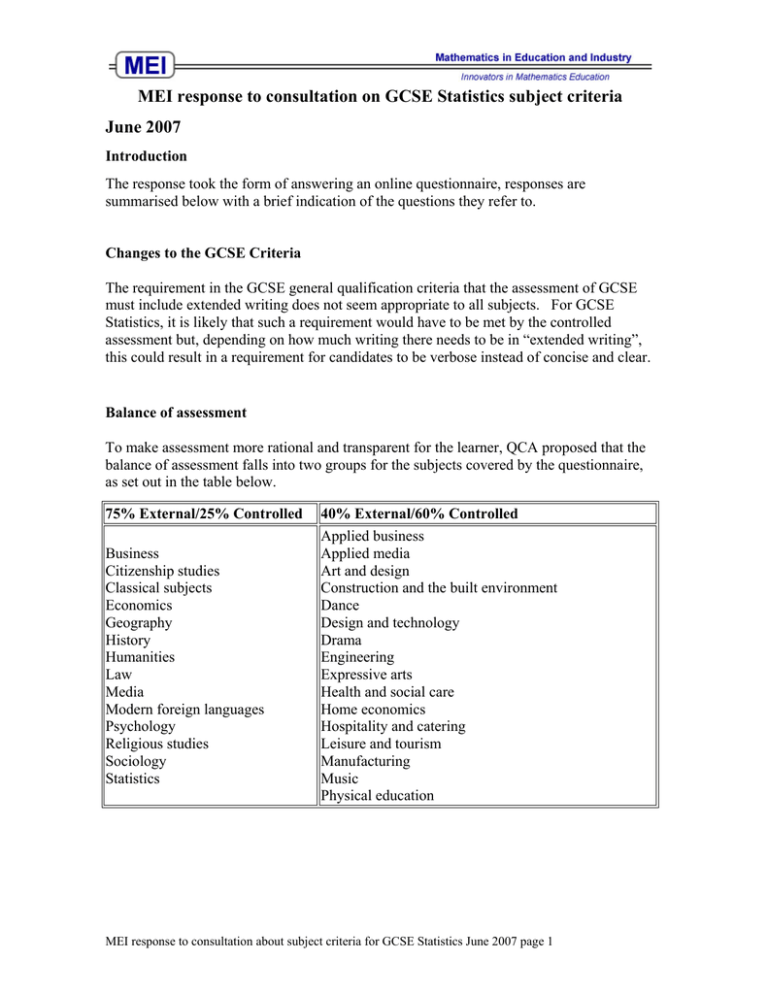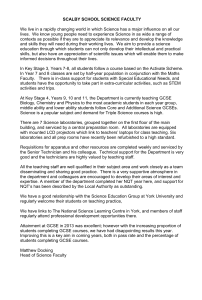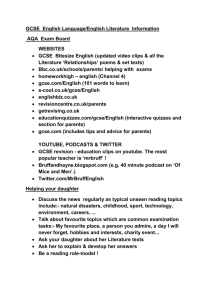MEI response to consultation on GCSE Statistics subject criteria June 2007
advertisement

MEI response to consultation on GCSE Statistics subject criteria June 2007 Introduction The response took the form of answering an online questionnaire, responses are summarised below with a brief indication of the questions they refer to. Changes to the GCSE Criteria The requirement in the GCSE general qualification criteria that the assessment of GCSE must include extended writing does not seem appropriate to all subjects. For GCSE Statistics, it is likely that such a requirement would have to be met by the controlled assessment but, depending on how much writing there needs to be in “extended writing”, this could result in a requirement for candidates to be verbose instead of concise and clear. Balance of assessment To make assessment more rational and transparent for the learner, QCA proposed that the balance of assessment falls into two groups for the subjects covered by the questionnaire, as set out in the table below. 75% External/25% Controlled Business Citizenship studies Classical subjects Economics Geography History Humanities Law Media Modern foreign languages Psychology Religious studies Sociology Statistics 40% External/60% Controlled Applied business Applied media Art and design Construction and the built environment Dance Design and technology Drama Engineering Expressive arts Health and social care Home economics Hospitality and catering Leisure and tourism Manufacturing Music Physical education MEI response to consultation about subject criteria for GCSE Statistics June 2007 page 1 It does not seem necessary to reduce the possibilities to two groups. Assessment which is rational and transparent to learners is assessment that is fit for purpose. The following principle from the QCA commissioned report “Improving GCSE: internal and controlled assessment” is commendable: “The intended learning outcomes in a subject are the critical factor in determining the appropriate form of assessment.” There is no reason to suppose that GCSEs should fit into two broad groups. As Mathematics, English and Science GCSEs are taken by the vast majority of students and do not figure in the “two broad groups” there will, in any case, be more than two models of assessment. GCSE Subject Specific Criteria Aims and Learning Outcomes The aims and learning outcomes needed to be amended in these ways: • • • • The start of paragraph 5 should read “GCSE specifications in Statistics should….” The third bullet point of section 5 should read “develop knowledge, skills and understanding in statistical methods and concepts and in probability, including…..” The fourth bullet point in section 5 does not make sense. Students might well organise their knowledge and understanding in creative and different forms; this is an aim and would not be assessed. Students should communicate their knowledge and understanding in ways that are understood by others. At GCSE level, this will almost certainly be in ways that are standard and well-known to those assessing the work. There is no learning outcome relating specifically to interpreting data. This is the crux of the subject. I suggest: “Interpret and communicate statistical information in a variety of forms appropriate to the information and context, including the use of ICT.” Content The content in the subject criteria is up to date and appropriate with the following adjustment. In section 13 “knowing the different types of sampling” and “knowing the different data collection methods” could be interpreted as meaning all of them – this is beyond the requirements of A Level so is somewhat ambitious for GCSE. Removing the word “the” from both statements would help. MEI response to consultation about subject criteria for GCSE Statistics June 2007 page 2 Assessment Objectives The assessment objectives do not indicate clearly what is to be assessed because there is no clear reference to the calculation and use of summary statistics. The objectives are distinct but inter-related, forming the successive stages of the data handling cycle. Their relative weightings are appropriate. Scheme of Assessment and Tiering The proposed tiering arrangements are appropriate. Whether the proposed balance between controlled and external assessment is appropriate will very much depend on the format of the external and controlled assessments. It is likely that the first two assessment objectives will be mainly tested in the controlled assessment. The weightings of the assessment objectives would allow the controlled assessment to address these objectives only but a task (or tasks) that required students to analyse a problem, plan a strategy and collect some data then do nothing with it would not be statistics. Maximising accessibility and equality The criteria enable awarding bodies to develop specifications that take into account the needs of all learners and that promote cultural understanding, diversity and gender equality appropriately. Physical disabilities might make it difficult for some candidates to collect primary data but AO2 allows selection of data, unless it is interpreted as meaning that all candidates must both collect and then select data. Difficulties with the English language might make it difficult for some candidates to communicate their findings; this could be catered for by allowing dictionaries and/or language assistants. MEI response to consultation about subject criteria for GCSE Statistics June 2007 page 3 Curriculum opportunities within the GCSE subject area I have not been able to find the overall objectives of the KS4 curriculum. The subject clearly contributes to the overall aims of enabling young people to become successful learners, confident individuals and responsible citizens; this is not spelled out in the subject criteria, nor does it need to be. The criteria will affect the specifications which will affect the textbooks which will affect what happens in the classroom. It is what happens in classrooms that determines whether the experience for students is coherent; the influence of the criteria on this is so indirect that it is difficult to say whether they contribute. Schools could use this subject to develop learning in contexts beyond the school. Statistics are widely used in all kinds of contexts including sport, industry and the media. It is difficult to think of a context beyond the school that could not be used. Whether the revised subject criteria give sufficient flexibility for awarding bodies to develop specifications that reflect subject and curriculum initiatives and developments depends what those initiatives are and how easily they can be made to fit in with 25% controlled assessment and 75% external assessment. MEI response to consultation about subject criteria for GCSE Statistics June 2007 page 4







